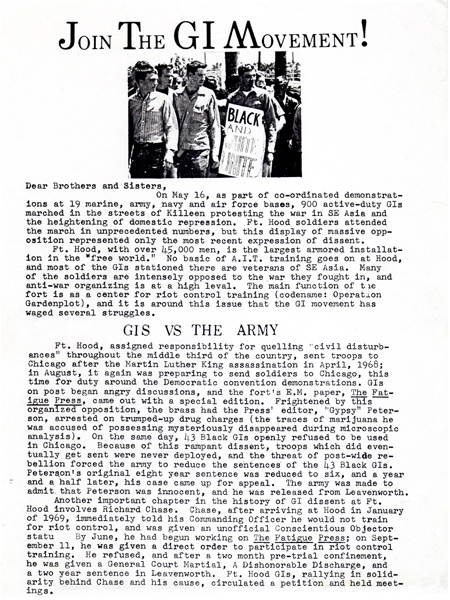Library - Flyers
Supporting Materials for Sir! No Sir!
Join the GI MOvement.
Dear Brothers and Sisters,
On May 16, as part of the co-ordinated demonstrations at 19 marine, army, navy and air force bases, 900 active-duty GIs marched in the streets of Killeen protesting the war in SE Asia and the heightening of domestic represssion. Ft. Hood soldiers attended in unprecedented numbers, but this display of massive opposition represented only the most recent expression of dissent.
Ft. Hood, with over 45,000 men, is the largest armored installation in the "free world." No basic or A.I.T. training goes on at Hood, and most of the G.I.s stationed there are veterans of S.E. Asia. Many of the soldiers are intensely opposed to the war they fought in, and anti-war organizing is at a high level. The main function of the forst is as a center for riot control training (codename: Operation Gardenplot), and it is around this issue that the GI movement has waged several struggles.
GIs Vs The Army
Ft. Hood, assigned responsibility for quelling "civil disturbances" throughout the middle third of the country, sent troops to Chicago after the Martin Luther King assasination in April 1968; in August, it again was preparing to send soldiers to Chicago, this time for duty around the Democratic convention demonstrations. GIs on post began angry discussions, and the Fort's E.M. paper, The Fatigue Press, came out with a special edition. Frightened by this organized opposition, the brass had the Press' editor, "Gypsy" Peterson, arrested on trulped-up drug charges (the traces of marijuana ne was accused of posessing mysteriously disapperaed during microscopic analysis). On the same day, 43 Black GIs openly refused to be used in Chicago. Because of this rampant dissent, troops which did eventually get sent were never deployed, and the treat of post-wide rebellion forced the Army to reduce the sentences of the 43 Black GIs. Peterson's original eight year sentence was reduced to six, and a year and a half later, his case came up for appeal. The Army was forced to admit that Peterson eas innocent, and he was released from Leavenworth.
Another important chapter in the history of GI dissent at Ft. Hood involves Richard Chase. Chase, after arriving at Hood in January of 1969, immediately told his Commanding Officer he would not train for riot control, and was given unofficial conscientious Objector status. By June, he had begun working on The Fatigue Press; on September 11, he was given a direct order to participate in riot control training. He refused, and after a two month pre-trial confinement he was given a general Court Martial, A Dishonorable Discharge, and a two year sentence in Leavenworth. Ft. Hood GIs, rallying in solidaruty behind Chase and his cause, circulated a petition and held meetings.
